When Eintracht Frankfurt sold André Silva to RB Leipzig for €23 million, everyone expected them to reinvest a part of that sum in a replacement. However, they were intelligent and took Rafael Santos Borré on a free transfer from River Plate instead.
Borré started his career in Deportivo Cali, where his fantastic performances quickly caught the attention of Atlético Madrid, who bought him for €5 million and left him on loan at his club for one season while he prepared for European football. Borré never played for Atlético and his only season in Europe was on loan at Villarreal in La Liga, where he played around 1,000 minutes and scored just four goals. After that, Atlético decided to sell him back to South America, where he has become one of the best in the continent playing for River Plate.
Getting one of the best strikers in South American football in his peak age (25) for free and beating interest from the Serie A and La Liga looks like an excellent move. In this scout report, we’ll have a look at Borré to see where he excels and how he can contribute to his new team.
Data overview and profile
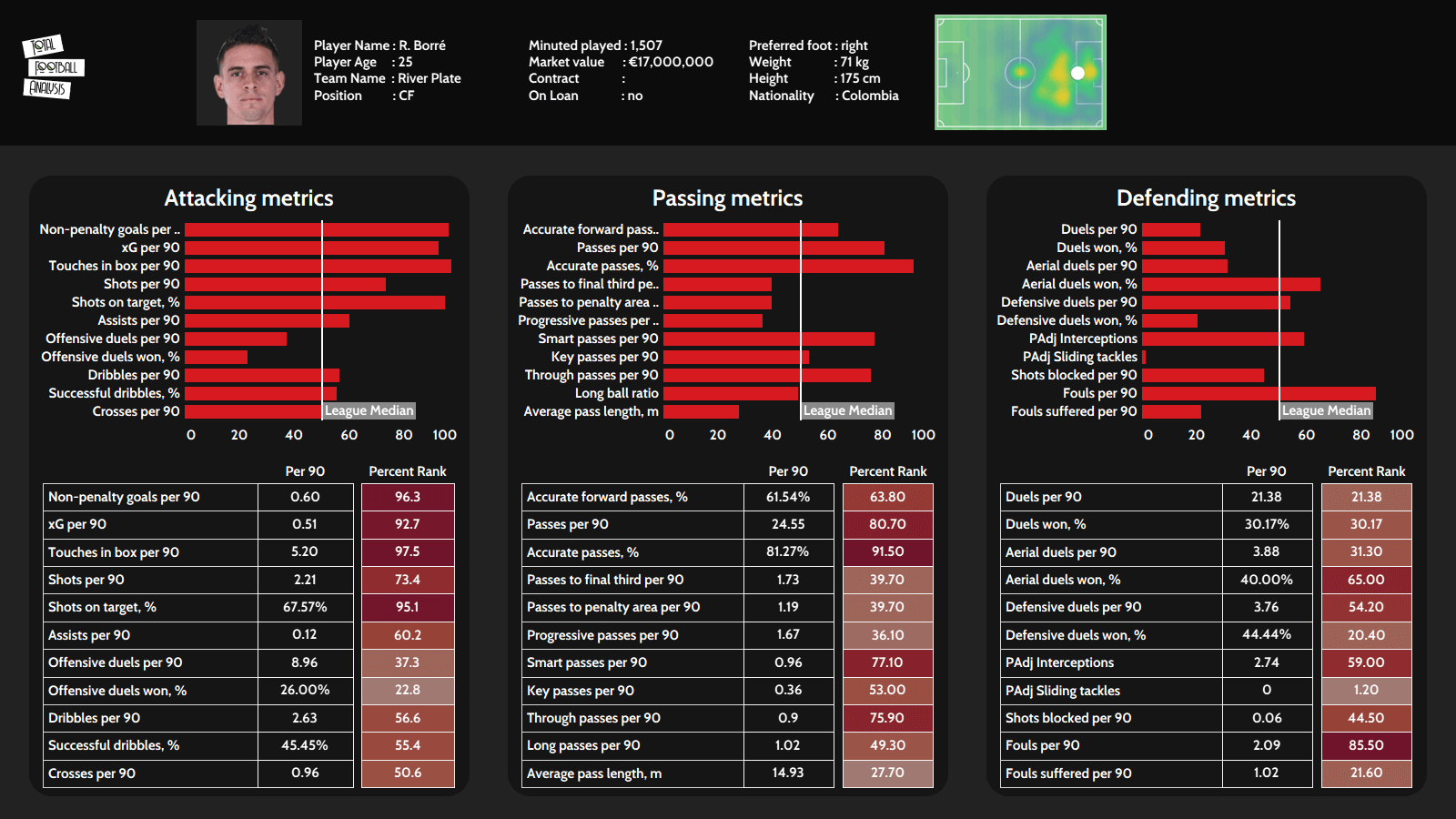
Borré is a striker with a lot of mobility and the ability to play all around the final third. Standing at 175 cm / 5’9’’, he’s not a towering presence in the box but has the physicality and speed to challenge for any ball and win duels against bigger defenders.
The first thing that stands out when looking at Borré’s statistical profile is his goalscoring ability. In the last year, he has scored 0.6 non-penalty goals from 0.51 xG per 90. He’s excellent at finding space in the box and a top poacher. The fact that he’s among the best strikers in the league in terms of goals and chances despite not shooting too much (2.21 shots per 90, top 26.6%) gives us a good idea of how dangerous the shots he takes are.
As we mentioned, Borré likes to drift wide and play in the second line. He’s among the strikers with more passes per 90 with 24.55 and has an excellent accuracy of 81.27%. He usually plays simple passes and layoffs but can also create chances and his through passes to the wings are often the start of a goalscoring action.
On the defensive side, Borré shows good awareness and stands out in possession adjusted interceptions. The rest of the defensive stats are relatively low because River Plate are a dominant team and he doesn’t get the chance to defend too much. He’s also good in the air, especially considering he’s not tall, winning 40% of his aerial duels.
Focal point in attack: combinations, progressing and playmaking
Borré is the main focus of River Plate’s attacks. He likes to drop to the second line to receive progressive passes with his back to goal. His layoffs are intelligent and accurate and he usually finds a better-placed teammate to continue the attack while also generating spaces behind him as the centre-backs hesitate to leave their position to mark him.
Often leaving the striker position to help his team progress, Borré benefits from playing with wingers who can make diagonal runs in behind to take advantage of the space he creates or midfielders who can arrive in the box. He also works well playing with another striker who pins the centre-backs and gives him more freedom to move around the final third.
We have a good example of how Borré plays with his back to goal in the next image. We see the moment Borré receives a pass that breaks two rival lines after an intelligent movement to create the passing lane. When he receives, he plays a quality layoff to his teammate who then has space to get forward and create a chance. With his movement, Borré also drags a defender out of place and creates a chance for his team to have a numerical advantage on the left.
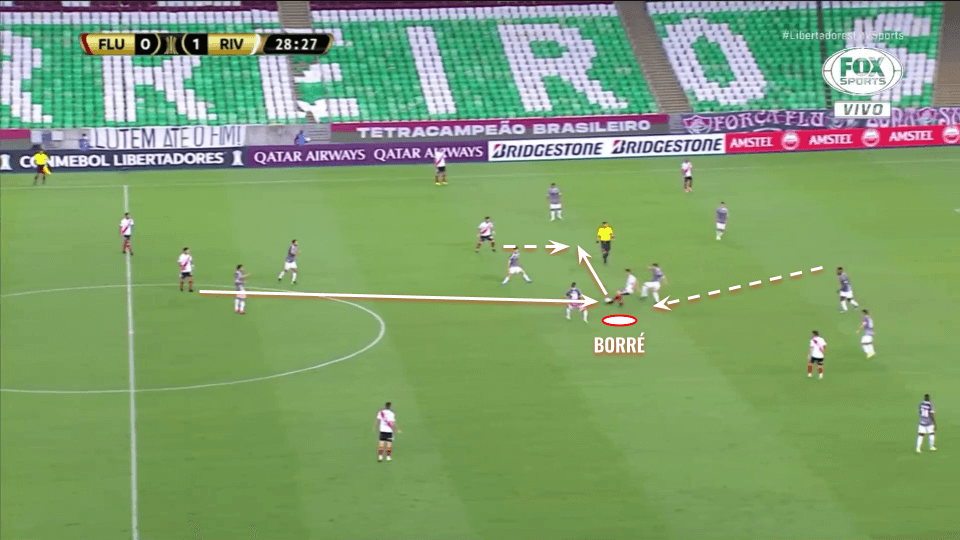
Borré has an excellent work rate in attack. We’ll see his movements to get into scoring positions in the next section of the analysis but he also moves around the opposition half to help his team progress and act as a playmaker.
Knowing he can create and take advantage of numerical advantages in different parts of the pitch, Borré often drops very deep and plays almost as an attacking midfielder. He’s one of the strikers in the Argentinian league with the most passes per 90 and also with one of the highest passing accuracies. In these aspects, he looks like FC Barcelona’s Antoine Griezmann, whose mobility and work rate to be involved in all aspects of the game are a very important part of his team’s attacks.
We’ve already seen Borré’s heatmap and that’s a very good clue about how much he likes to move around the final third. He has a lot of presence at the edge of the box and in both half-spaces, looking to receive the ball in those zones before progressing and creating with his passing quality.
In the next picture, we see an example of Borré in a playmaker role. With Colombia facing Uruguay’s deep block, Borré moves away from the crowd to receive the ball in midfield. The rivals hesitate to follow him and he creates the time to raise his head and spot the best possible passing option, switching the game to the left with an excellent diagonal pass.
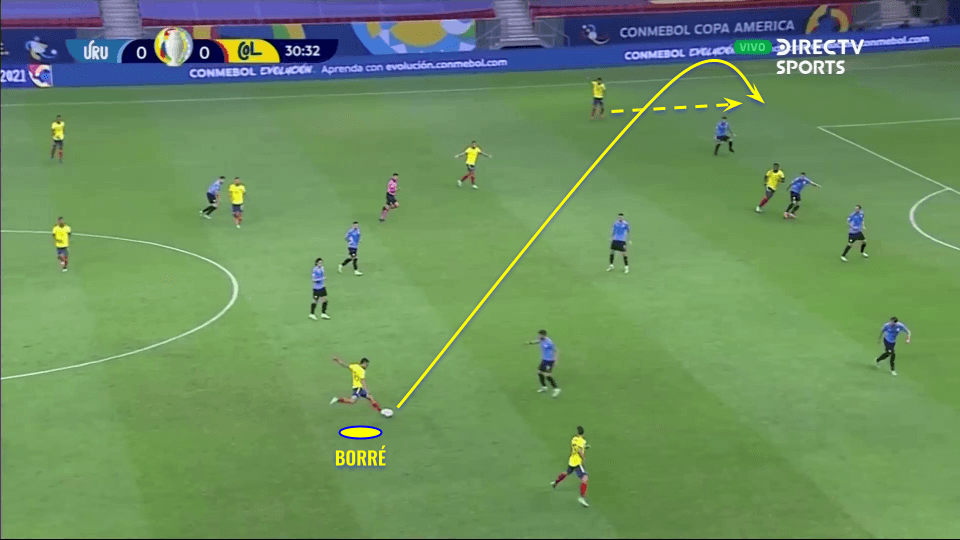
The previous play is an example of how Borré reads the game and is ready to take responsibility not only as the goalscorer but also as the playmaker for his team. In some matches, he has almost played as a central midfielder with two strikers in front of him and complete freedom to drift wide, come deep to advance with passes and combinations and then arrive at the box. This flexibility in his role will be key for him to succeed at Eintracht Frankfurt.
His work rate also means that he’s a very important player in attacking transitions. He can get the ball in his own half and command the counterattack with well-chosen passes. Again, it’s not only choosing the correct pass that makes him a good player for a counterattacking team but also his intelligence to make the right movements and be always ready to receive the ball back and continue progressing.
Let’s have a look at the next sequence. In the first picture, Colombia have just recovered the ball and he receives it very deep with a chance to counterattack. In just two touches, he turns and spots his free teammate, playing a good line-breaking pass. After the pass, he moves up and receives the layoff from his teammate, being again in a position to progress into the opposition half with a lobbed pass. The keys for this combination that creates an excellent chance to counterattack are Borré’s movement after the first pass and his overview to play with one or two touches and progress quickly.
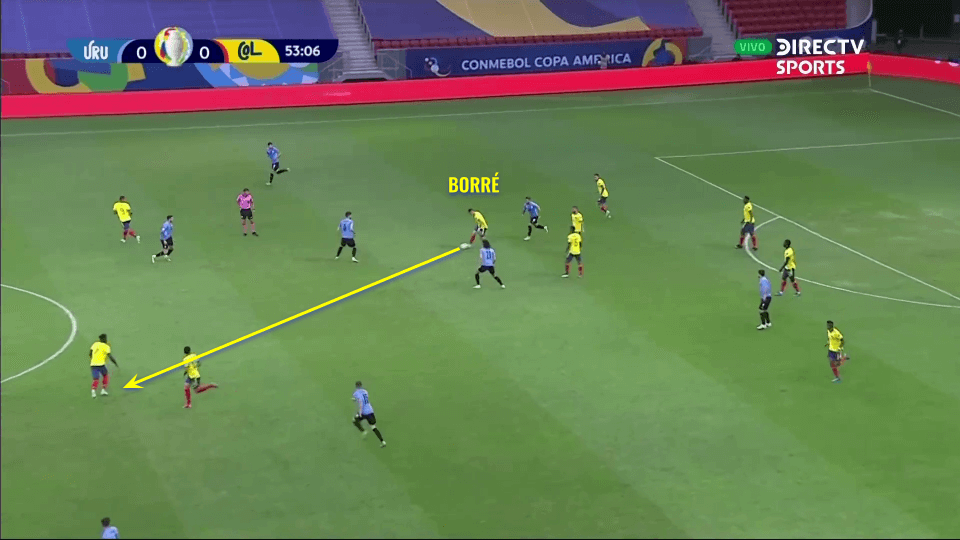
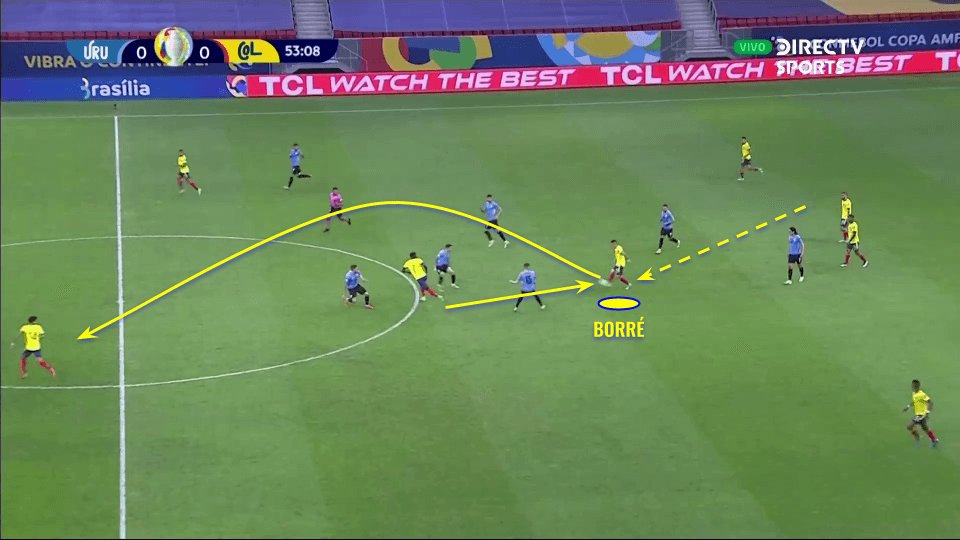
Borré also stands out as an excellent creator from the second line. His movements and coordination with his teammates create spaces in the rival defence that he knows how to attack. He has a good passing range and the quality to play well-weighted through passes and crosses.
The map below shows all the accurate key passes Borré made in the last season. Most of them come from the right half-space but he also creates from the wings, midfield and with quality layoffs in the box.
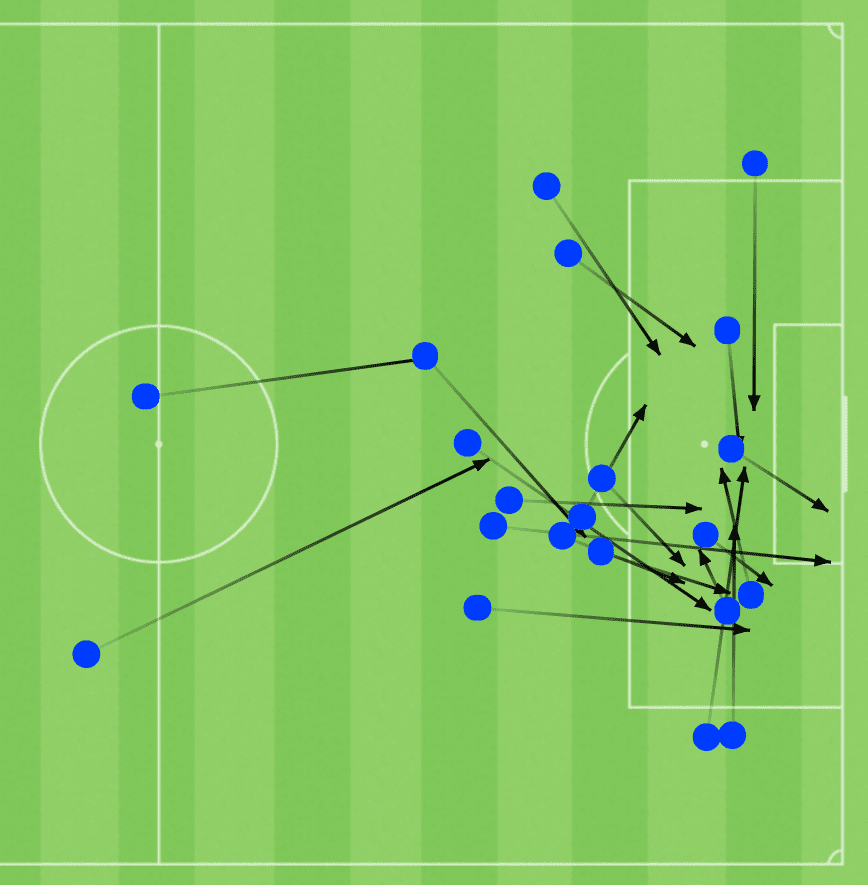
Let’s see some examples of different ways Borré uses to create chances for his teammates. In the first example, he has dropped very deep and plays a fantastic long ball over the defensive line to assist the striker’s run. Knowing his passing quality, Borré’s teammates will usually move and run in behind when he gets the ball.
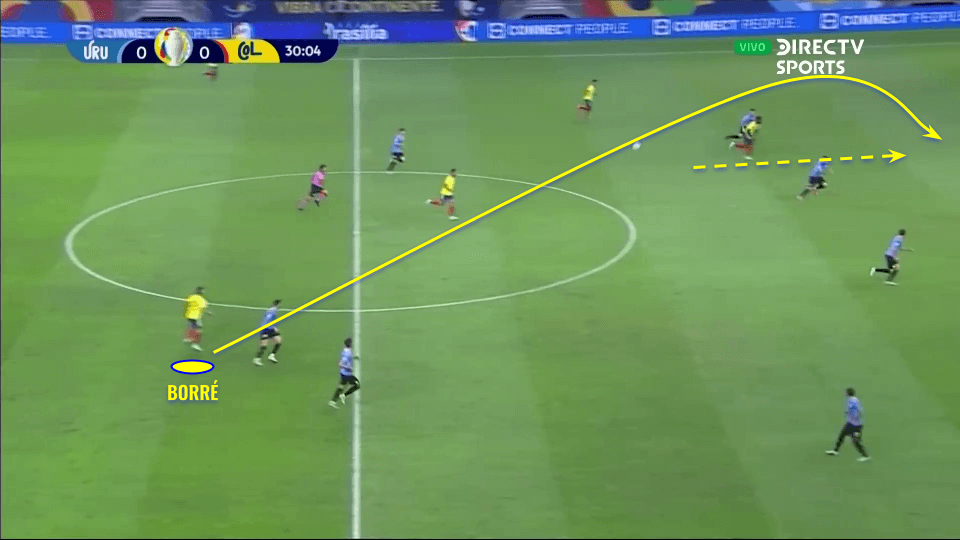
In the second one, Borré is around the right half-space, his favourite place to create as we’ve seen in the previous graph. Again, his movement away from the marker allows him some space and time to raise his head and spot the striker’s movement. His cross finds the run and only Fernando Muslera’s save prevents Duván Zapata from scoring. Apart from the vision, this cross requires an excellent delivery and Borré also has that in him.
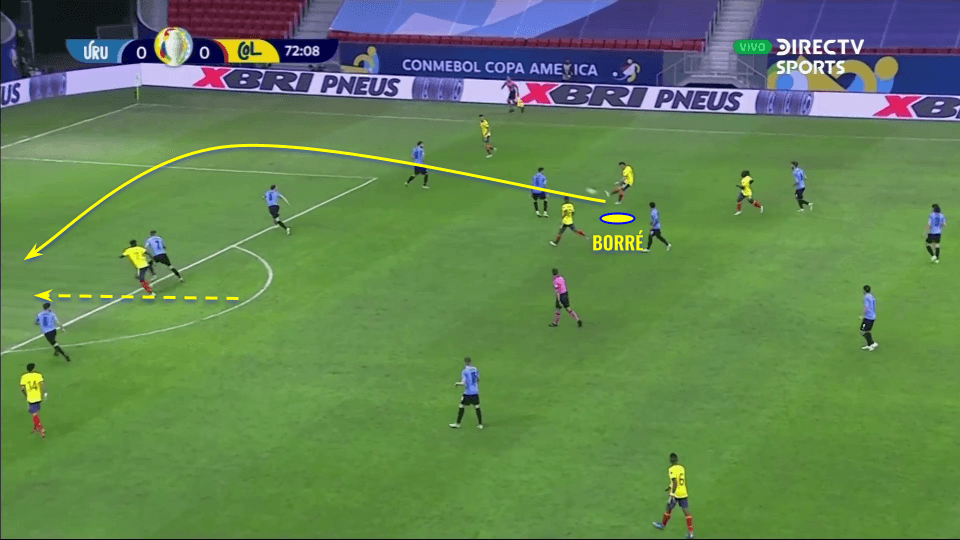
The last example shows us Borré’s quality to assist with through passes. Borré makes a perfect pass between five Fluminense defenders, this time from the left half-space, and creates a chance. It’s interesting to note that the player receiving the ball is one of River Plate’s central midfielders who runs into the space Borré has left free when drifting away from the striker position.
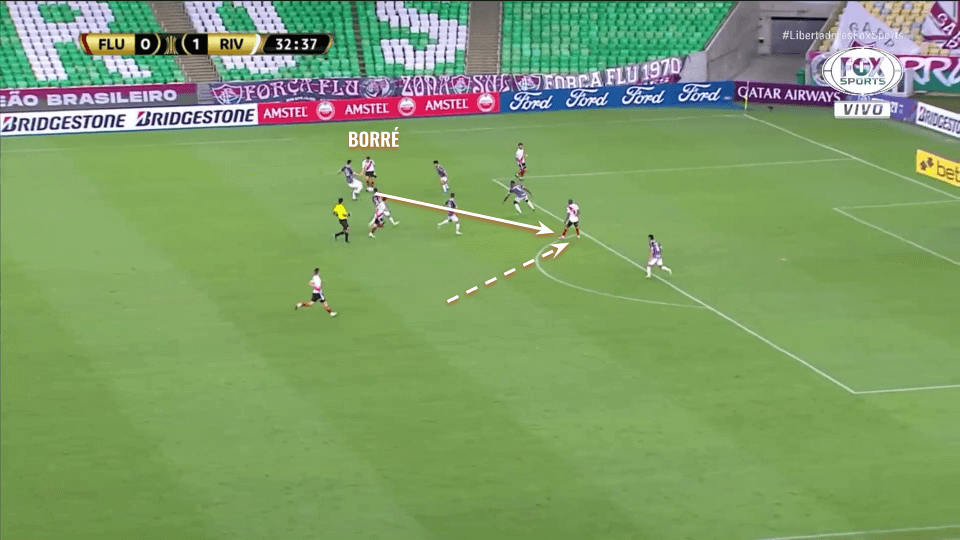
Intelligent movement and finishing
Despite being an excellent player in the buildup and creating chances, it’s Borré’s goalscoring record in the last few seasons that has attracted Eintracht Frankfurt. Borré has scored 56 goals in 149 appearances for River Plate in the last four years, around 0.54 goals per 90.
He has become more and more reliable in front of goal as the seasons have gone by. At the beginning of his career, he depended a lot on streaks but wasn’t a consistent finisher. That’s probably the reason why his first season in Europe was quite disappointing.
If we look at Borré’s whole career, he has scored almost as many goals as expected. He has underperformed his xG by just 1.2%. If we consider he was underperforming much more in his first seasons, that shows his improvement and if we look at the data from his last season, he has scored 0.6 non-penalty goals per 90 from 0.51 xG so his finishing is above average.
Looking at Borré’s shot map from last season, we clearly see how his goalscoring record has improved. Most of his goals come from high-quality chances from inside the 6-yard box or very close to it. His intelligence allows him to get into situations where finishing quality isn’t key and he’s one of the best poachers around. His finishing from other kinds of plays is just ok, hitting the target 67.5% of the time (top 5% among strikers in the Argentinian league) but lacking that extra finishing quality to score.
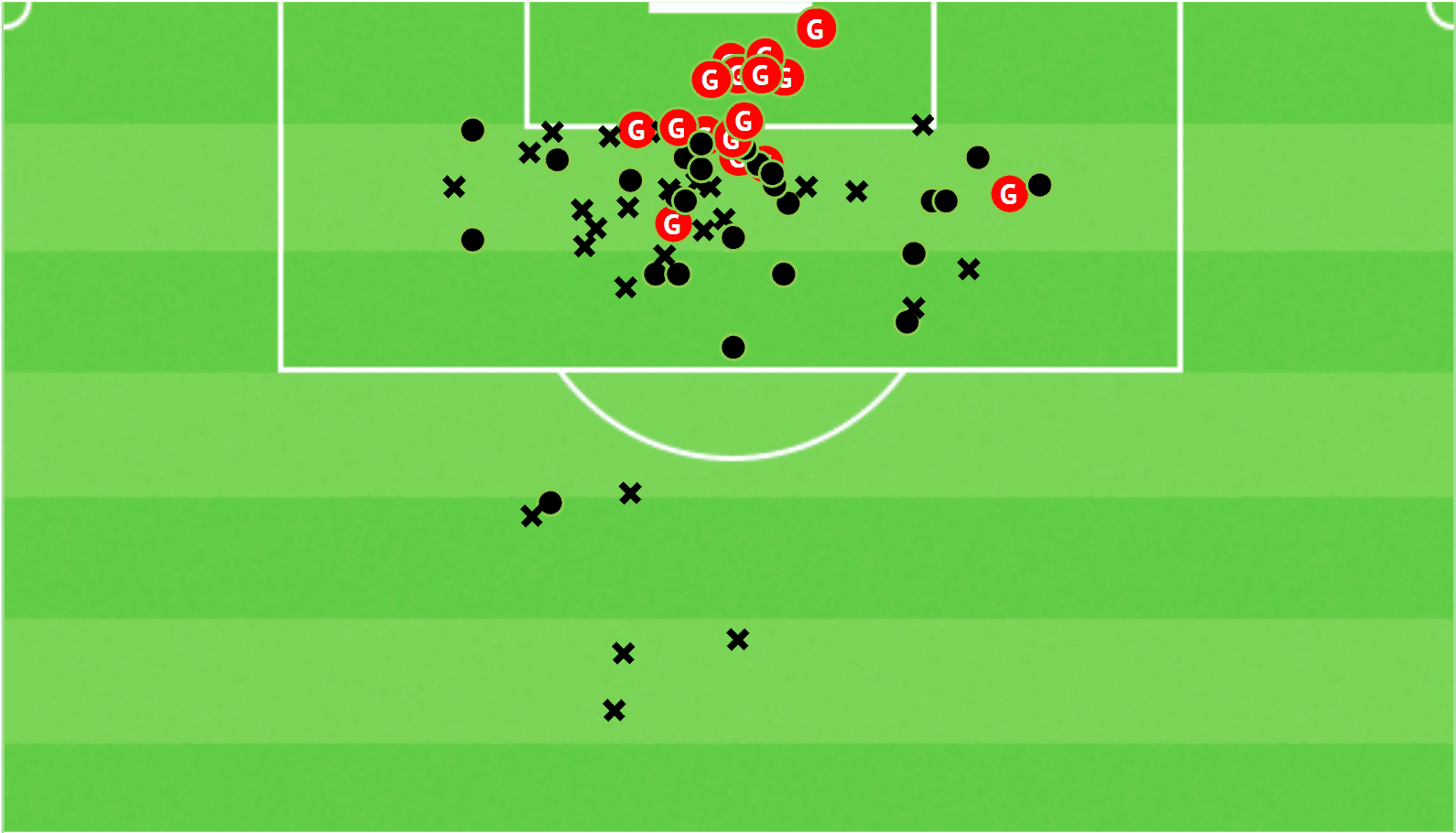
As we saw in the previous section of the scout report, Borré’s movements create a lot of spaces that are often occupied by his teammates but also by him. He’s eager to run into space between the full-back and the centre-back and is always asking questions to the defensive line with his variety and quality of movement.
The next example shows us exactly that. Borré starts the play in the right half-space, looking to receive and play from there as we’ve already seen before. When he sees he won’t have the ball there and there’s space between the rival defenders, he makes a run in behind. With his acceleration, he gets to the ball before the goalkeeper and provokes a penalty.
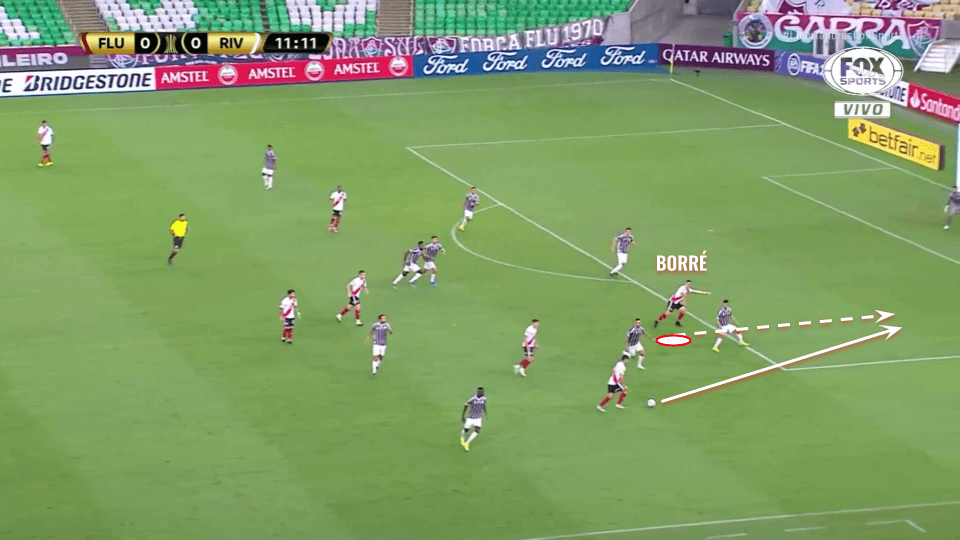
Most of Borré’s goals come from being one step ahead of the play. He gets into good positions before the chance to receive the ball even exists and times his movements very well to sweep the far post and score apparently easy goals. He likes to stand in an offside position so the rivals can’t mark him and when the ball goes wide he has the small advantage he needs to receive and score.
The next sequence illustrates Borré’s intelligent positioning very well. In the first picture, he’s offside so he can’t receive the ball but is unmarked. The ball goes to the right and then he has the advantage over the centre-backs to receive the cross completely free and score the tap in.
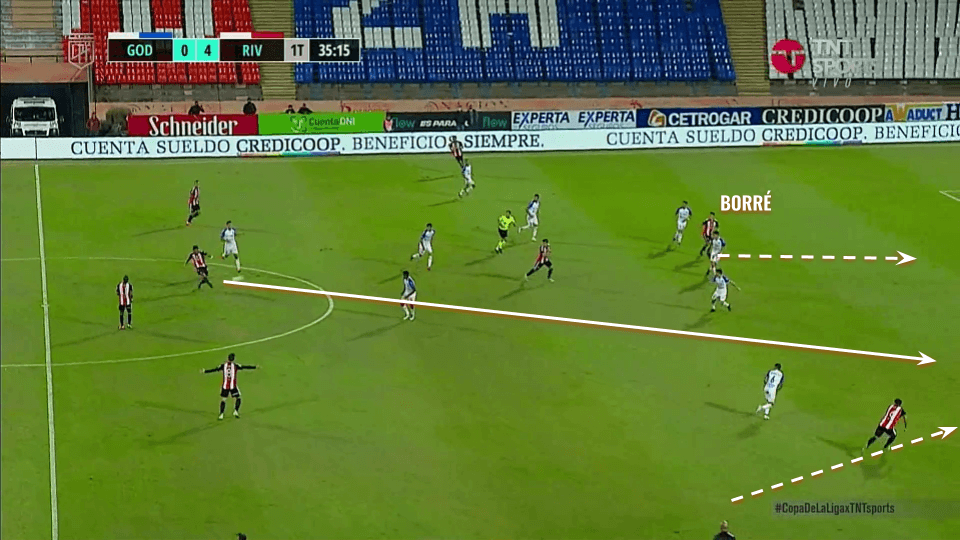
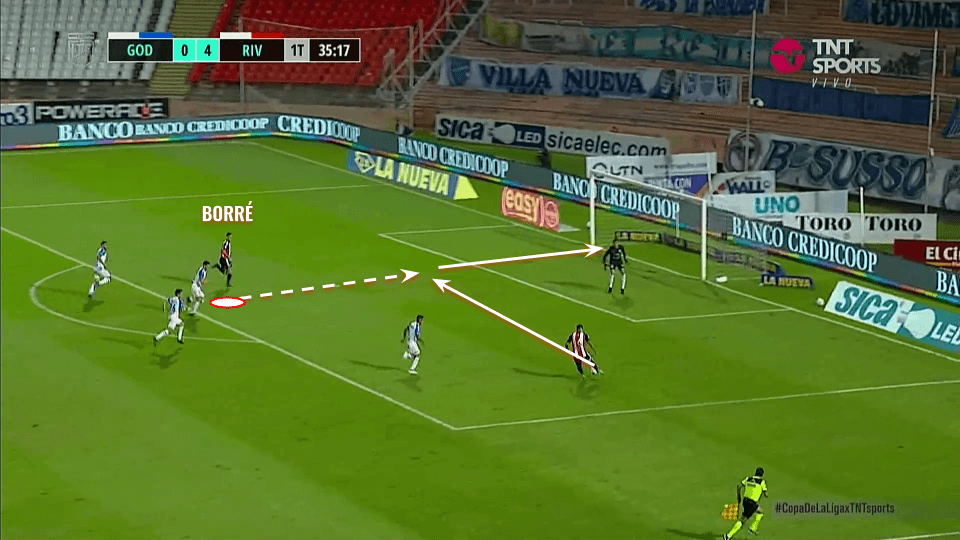
It’s this ability to read the game and anticipate what’s going to happen that makes Borré stand out. His positioning and movement always have an intention and he consistently gets into excellent scoring positions.
Once Borré adapts to his new team’s tactics and starts to understand how his teammates play and what they’re going to do next, we can expect him to make the right decisions and score lots of goals.
Conclusion
Borré is a much more mature player now than he was during his first European adventure at Villarreal. His physicality has improved and he has found different ways to create things with his intelligence and movements.
After being one of the most important players in arguably the best team in South America for five seasons, winning the Copa Libertadores and getting into the Colombian national team, it felt like Borré deserved a second chance in a top league like the Bundesliga. Getting him on a free to substitute André Silva seems like an intelligent move by Eintracht Frankfurt and if he adapts quickly we can expect a lot of Borré this season.

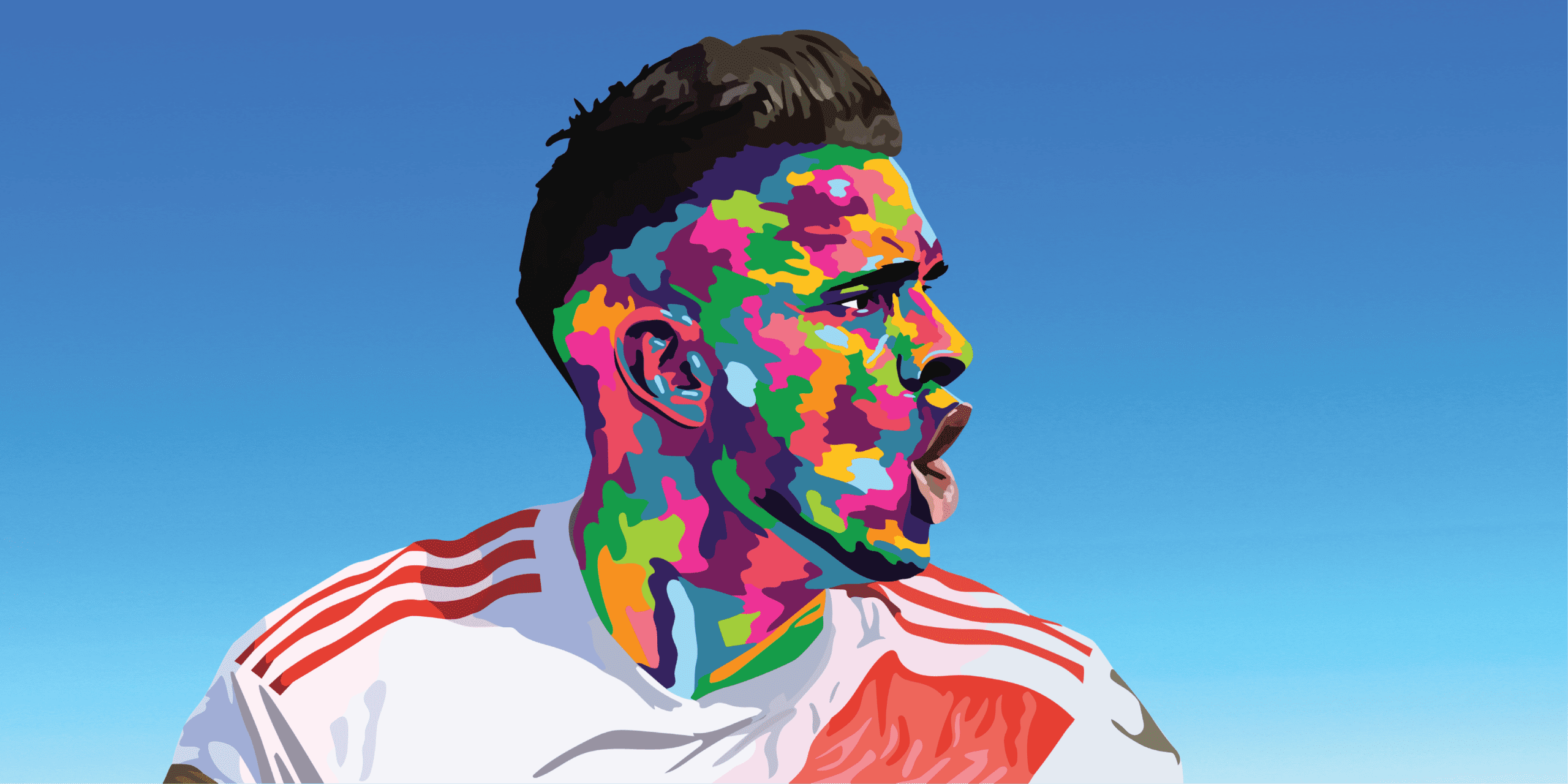



Comments